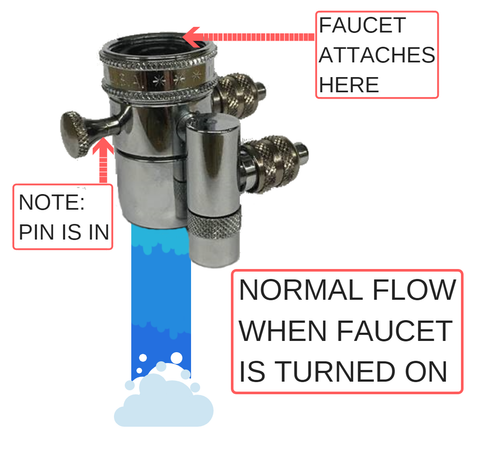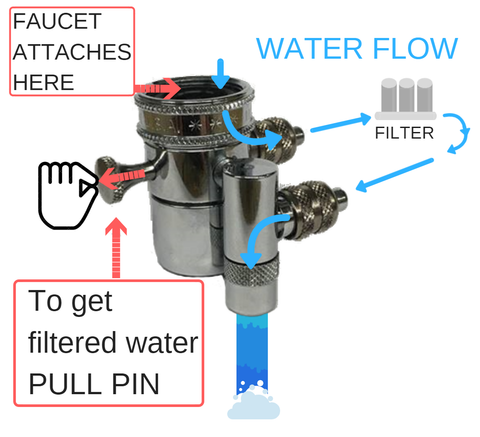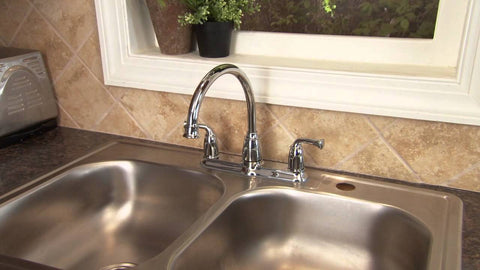Sink Filtration is a great option for those looking to get clean water from the most convenient source in their house – the kitchen sink. Countertop and Under the Sink Filters are known as Point of Use filters (POU) as they serve to filter the water directly before you use it. Often times they can be installed directly onto your existing kitchen faucet or require the installation of a second faucet. Both Countertop and Under-the-Sink filters will give you the same quality of water, it’s just a matter of deciding which version is right for you and your kitchen set up.
Main Difference
The obvious difference between the Countertop and Under-the-Sink models is that one sits atop the counter, and is in plain sight, whereas the other one gets tucked away in the space underneath your kitchen sink, in the cabinet where we often keep our cleaning supplies or other miscellaneous kitchen products.
One of the main things to determine when comparing Countertop and Under-the-Sink is simply do you have the space available on your kitchen counter to fit a Countertop filter? If your counter is cluttered or small and you don’t have space for the filters, then it’s better to go with an Under-the-Sink.
Proper Faucet
If space isn’t an issue, the next thing to look at is the type of kitchen faucet you have. Countertop filters work by attaching a piece of equipment called a “Diverter Valve” to the end of your faucet. This diverter valve screws on to the end of your faucet and serves to “divert” the flow of water to your unit. Once screwed on, your faucet will operate normally.

In order to get the filtered water, you have to divert the water to the filter by pulling a special pin located on the side of the diverter valve. Once it is pulled, it will stop the flow of water from your normal faucet and divert the water towards your unit to be filtered. After the water is filtered it exits the unit and travels back to the diverter valve. The diverter valve has a second (separate) opening for the filtered water to come out, this way the filtered water never mixes with unfiltered water.

Diverter valves are super easy to use and require little to no maintenance. As far as installation goes on a countertop unit, the only installation required is screwing on the diverter valve. Which brings me to my main point. In order for the diverter valve to work it must be screwed on to the end of your faucet. This might seem obvious but it means that if you have a faucet that doesn’t have threads, the diverter valve will not work and therefore you may have to opt for an under the sink unit. The size of the threads doesn’t matter as adapter pieces are included to fit to any size faucet. Older style faucets will typically have an aerator attachment that can be unscrewed to reveal threads. This is where you would install the diverter valve. Some specialty faucets may not have threads as well as modern-style and detachable faucets typically won't either.
If your faucet DOES NOT have threads, meaning you can't attach the diverter valve, than an Under-the-Sink filter is the way to go.
If your faucet DOES have threads, than that's great you have the option of going for either a Countertop Filter or Under-the-Sink Filter.
So now some of you will be thinking: “Great! I have plenty of space on my counter and a faucet that has threads… I’m good to go!”
And if not, then Under-the-Sink might be the way to go.
Installing an Under-the-Sink
Let’s say you decide to go with an under-the sink unit. Maybe you don’t want to give up the counter space, or prefer it being out of sight, or have a newer style faucet that doesn’t have threads. Great! Under-the-Sink filters work just as easily as Countertops only require a little more installation.
Under-the-Sink filters will come with a lead-free faucet in your choice of brushed nickel or chrome finishes. You can choose whichever best matches your existing faucet. This faucet gets installed right next to your existing faucet. Often times your sink will have a spare opening where other faucets/accessories can be installed. This is where you’d install a soap dispenser or one of those “water guns” for cleaning dishes.

Your lead-free faucet can be installed on ANY type of countertop or sink whether it’s stainless steel, enamel, or granite. If a hole is not already available on your sink it is possible to drill a new one. Instructions for how to drill into a stainless steel or enamel sink are included in our installation guide.
For granite countertops, the process is similar but requires a special drill bit. Granite has become an increasingly popular choice for countertops because of its hard, smooth surface and modern look. It certainly is possible to install a second faucet onto these surfaces; however it is a bit more time-consuming. We recommend having someone familiar with granite countertops and more importantly with the proper equipment do the actual drilling. Plenty of tutorials and videos are also available online to help guide you in drilling correctly. Some helpful resources include this instructional blog and this youtube video, although there are plenty more out there.
When deciding whether or not to install a sink unit, it’s important to weigh these factors to figure out which version will work for you. Think about which would be easier for you, and which you can see yourself using for many years to come. A Point-of-Use water filter is the best way to get great-tasting, clean drinking water from the most convenient source in your home – the kitchen sink. There are benefits to choosing each style of filter, it's just a matter of looking at your kitchen set up and deciding which one is right for you!





Leave a comment